Analysis of Rigid-Flexible Coupling Characteristics of Pneumatic Modular Soft Joints with Variable Stiffness
Abstract
1. Introduction
2. Structure Principle
3. Modeling and Solving
3.1. Deformation Modeling
3.2. Variable Stiffness Modeling
- (1)
- The magnetorheological fluid cannot be compressed in the flow process and can maintain long-term stability;
- (2)
- The flow effect of magnetorheological fluid in both axial and radial directions of the joint is negligible;
- (3)
- The flow velocity of the magnetorheological fluid in modular joints is only related to the joint radius;
- (4)
- The magnetorheological fluid has the same pressure in the radial direction of the joint.
4. Simulation Analysis
- Pneumatic soft channel and magnetic fluid structure are set up. The material density of the pneumatic soft channel is 1200 kg/m3. The Yeoh elastomer model is adopted, C10 = 0.11, and C20 = 0.02. Create a new MDL material and set the shear modulus as shown in G in Figure 6. Poisson’s ratio is 0.45, and density is 3450 kg/m3.
- Import the model and divide the grid. Set the mesh shape to tetrahedron and the cell size to 2 mm.
- Apply load and constraint: set the right end plane of the soft joint as fixed support and the left end as free end. The load form is pressure, and the acting surface is the wall of the pneumatic channel.
- Open the large deformation mode (for the simulation of elastomer with large deformation), and set the maximum number of iteration sub-steps to 10,000.
- Start simulation calculation to obtain strain and stress data and cloud image
4.1. Parameter Settings
4.2. Deformation Simulation
4.2.1. Deformation Simulation without Magnetic Field
4.2.2. Pressurize Single Channel with Different Magnetic Fields
4.2.3. Pressurize the Two Channels under Various Magnetic Fields
4.3. Variable Stiffness Simulation
5. Test
5.1. Experimental Design
5.1.1. Deformation Test
5.1.2. Variable Stiffness Test
6. Conclusions
- (1)
- The deformation and variable stiffness models are established, and the gas pressure and deformation amount, and the correspondence between the magnetic field strength and the stiffness of the drive module, are obtained.
- (2)
- Through finite element simulation analysis, the change law of pressure and deformation under different stiffness conditions is obtained, and the change law of magnetic field strength and joint stiffness under different deformation conditions is considered.
- (3)
- Experiments verify the theoretical analysis, and the experiments show that, under the simultaneous action of deformation and variable stiffness, the compliance and bearing capacity are taken into account, and the experimental results of the drive module are in good agreement with the calculation and simulation results of the theoretical model.
Author Contributions
Funding
Data Availability Statement
Conflicts of Interest
References
- Xu, F.-Y.; Jiang, F.-Y.; Jiang, Q.-S.; Lu, Y.-X. Soft Actuator Model for a Soft Robot with Variable Stiffness by Coupling Pneumatic Structure and Jamming Mechanism. IEEE Access 2020, 8, 26356–26371. [Google Scholar] [CrossRef]
- Gilday, K.; Hughes, J.; Iida, F. Wrist-driven passive grasping: Interaction-based trajectory adaption with a compliant anthropomorphic hand. Bioinspir. Biomim. 2021, 16, 026024. [Google Scholar] [CrossRef] [PubMed]
- Zhou, P.; Yao, J.; Zhang, S.; Wei, C.; Zhang, H.; Qi, S. A bioinspired fishbone continuum robot with rigid-flexible-soft coupling structure. Bioinspir. Biomim. 2022, 17, 066012. [Google Scholar] [CrossRef]
- Chen, J.; Jin, H.; Iida, F.; Zhao, J. A design concept of parallel elasticity extracted from biological muscles for engineered actuators. Bioinspir. Biomim. 2016, 11, 056009. [Google Scholar] [CrossRef]
- Wockenfu, W.R.; Brandt, V.; Weisheit, L.; Drossel, W.-G. Design, Modeling and Validation of a Tendon-Driven Soft Continuum Robot for Planar Motion Based on Variable Stiffness Structures. IEEE Robot. Autom. Lett. 2022, 7, 3985–3991. [Google Scholar] [CrossRef]
- Wang, Y.; Yang, X.; Chen, Y.; Wainwright, D.K.; Kenaley, C.P.; Gong, Z.; Liu, Z.; Liu, H.; Guan, J.; Wang, T.; et al. A biorobotic adhesive disc for underwater hitchhiking inspired by the remora suckerfish. Sci. Robot. 2017, 2, eaan8072. [Google Scholar] [CrossRef]
- Gu, G.; Zou, J.; Zhao, R.; Zhao, X.; Zhu, X. Soft wall-climbing robots. Sci. Robot. 2018, 3, eaat2874. [Google Scholar] [CrossRef]
- Seok, S.; Onal, C.D.; Cho, K.-J.; Wood, R.J.; Rus, D.; Kim, S. Meshworm: A peristaltic soft robot with antagonistic nickel titanium coil actuators. IEEE/ASME Trans. Mechatronics 2012, 18, 1485–1497. [Google Scholar] [CrossRef]
- Kashima, S.; Miyasaka, F.; Hirata, K. Novel soft actuator using magnetorheological elastomer. IEEE Trans. Magn. 2012, 48, 1649–1652. [Google Scholar] [CrossRef]
- Wang, H.; Wang, C.; Chen, W.; Liang, X.; Liu, Y. Three-dimensional dynamics for cable-driven soft manipulator. IEEE/ASME Trans. Mechatron. 2016, 22, 18–28. [Google Scholar] [CrossRef]
- Sun, Y.; Zhang, Q.; Chen, X.; Chen, H. An Optimum Design Method of Pneu-Net Actuators for Trajectory Matching Utilizing a Bending Model and GA. Math. Probl. Eng. 2019, 2019, 6721897. [Google Scholar] [CrossRef]
- Niu, C.; Luan, C.; Shen, H.; Song, X.; Fu, J.; Zhang, L.; Sun, Y.; Xu, G.; Ruan, Z. Tunable soft–stiff hybridized fiber-reinforced thermoplastic composites using controllable multimaterial additive manufacturing technology. Addit. Manuf. 2022, 55, 102836. [Google Scholar] [CrossRef]
- Yang, Y.; Chen, Y.; Li, Y.; Wang, Z.; Li, Y. Novel variable-stiffness robotic fingers with built-in position feedback. Soft Robot. 2017, 4, 338–352. [Google Scholar] [CrossRef] [PubMed]
- Li, Y.; Chen, Y.; Yang, Y.; Wei, Y. Passive Particle Jamming and Its Stiffening of Soft Robotic Grippers. IEEE Trans. Robot. 2017, 33, 446–455. [Google Scholar] [CrossRef]
- Huang, L.; Hu, H.; Ouyang, Q. Design and Feasibility Study of MRG–Based Variable Stiffness Soft Robot. Micromachines 2022, 13, 2036. [Google Scholar] [CrossRef]
- Konda, R.; Bombara, D.; Swanbeck, S.; Zhang, J. Anthropomorphic Twisted String-Actuated Soft Robotic Gripper with Tendon-Based Stiffening. IEEE Trans. Robot. 2022, 39, 1178–1195. [Google Scholar] [CrossRef]
- Shiva, A.; Stilli, A.; Noh, Y.; Faragasso, A.; De Falco, I.; Gerboni, G.; Cianchetti, M.; Menciassi, A.; Althoefer, K.; Wurdemann, H.A. Tendon-Based Stiffening for a Pneumatically Actuated Soft Manipulator. IEEE Robot. Autom. Lett. 2016, 1, 632–637. [Google Scholar] [CrossRef]
- Crowley, G.B.; Zeng, X.; Su, H.-J. A 3D Printed Soft Robotic Gripper with a Variable Stiffness Enabled by a Novel Positive Pressure Layer Jamming Technology. IEEE Robot. Autom. Lett. 2022, 7, 5477–5482. [Google Scholar] [CrossRef]
- Zhao, Y.; Shan, Y.; Guo, K.; Han, L.; Qi, L.; Yu, H. Principle and Performance Analysis of Soft Continuum Robot with Large Range Variable Stiffness Based on Spherical Particles. In Proceedings of the 2019 IEEE 9th Annual International Conference on CYBER Technology in Automation, Control, and Intelligent Systems (CYBER), Suzhou, China, 29 July–2 August 2019; pp. 719–724. [Google Scholar]
- Al Abeach, L.A.; Nefti-Meziani, S.; Davis, S. Design of a Variable Stiffness Soft Dexterous Gripper. Soft Robot. 2017, 4, 274–284. [Google Scholar] [CrossRef]
- Al Abeach, L.; Nefti-Meziani, S.; Theodoridis, T.; Davis, S. A Variable Stiffness Soft Gripper Using Granular Jamming and Biologically Inspired Pneumatic Muscles. J. Bionic Eng. 2018, 15, 236–246. [Google Scholar] [CrossRef]
- Li, Y.; Ren, T.; Chen, Y.; Chen, M.Z. A variable stiffness soft continuum robot based on pre-charged air, particle jamming, and origami. In Proceedings of the 2020 IEEE International Conference on Robotics and Automation (ICRA), Paris, France, 31 May–31 August 2020; pp. 5869–5875. [Google Scholar]
- Wang, T.; Zhang, J.; Li, Y.; Hong, J.; Wang, M.Y. Electrostatic Layer Jamming Variable Stiffness for Soft Robotics. IEEE/ASME Trans. Mechatron. 2019, 24, 424–433. [Google Scholar] [CrossRef]
- Liu, Z.; Wang, Y.; Wang, J.; Fei, Y.; Du, Q. An obstacle-avoiding and stiffness-tunable modular bionic soft robot. Robotica 2022, 40, 2651–2665. [Google Scholar] [CrossRef]
- Luo, Y.; Wright, M.; Xiao, Q.; Yue, H.; Pan, G. Fluid–structure interaction analysis on motion control of a self-propelled flexible plate near a rigid body utilizing PD control. Bioinspir. Biomim. 2021, 16, 066002. [Google Scholar] [CrossRef] [PubMed]
- Wang, C.; Tang, H.; Zhang, X. Fluid-structure interaction of bio-inspired flexible slender structures: A review of selected topics. Bioinspir. Biomim. 2022, 17, 041002. [Google Scholar] [CrossRef]
- Stano, G.; Ovy, S.a.I.; Percoco, G.; Zhang, R.; Lu, H.; Tadesse, Y. Additive Manufacturing for Bioinspired Structures: Experimental Study to Improve the Multimaterial Adhesion Between Soft and Stiff Materials. 3D Print. Addit. Manuf. 2023; ahead of print. [Google Scholar] [CrossRef]
- Shan, Y.; Zhao, Y.; Pei, C.; Yu, H.; Liu, P. A novel design of a passive variable stiffness soft robotic gripper. Bioinspir. Biomim. 2022, 17, 066014. [Google Scholar] [CrossRef]
- Sun, W.; Yu, J.; Cai, Y. Influence of magnetic field, magnetic particle percentages, and particle diameters on the stiffness of magnetorheological fluids. J. Intell. Mater. Syst. Struct. 2020, 31, 2312–2325. [Google Scholar] [CrossRef]
- Ilievski, F.; Mazzeo, A.D.; Shepherd, R.F.; Chen, X.; Whitesides, G.M. Soft robotics for chemists. Angew. Chem. Int. Ed. 2011, 50, 1890–1895. [Google Scholar] [CrossRef]
- Yap, H.K.; Ng, H.Y.; Yeow, C.-H. High-Force Soft Printable Pneumatics for Soft Robotic Applications. Soft Robot. 2016, 3, 144–158. [Google Scholar] [CrossRef]
- Liu, S.Y.; Zhang, J.T.; Wang, J.; Deng, Y.J.; Xin, C.T. Design and simulation analysis of fluid-driven modular soft body bionic elephant trunk joint variable stiffness structure. Hydraul. Pneum. 2022, 46, 152–158. [Google Scholar]
- Zhang, Y.; Chen, W.; Chen, J.; Cheng, Q.; Zhang, H.; Xiang, C.; Hao, L. Stiffness Analysis of a Pneumatic Soft Manipulator Based on Bending Shape Prediction. IEEE Access 2020, 8, 82227–82241. [Google Scholar] [CrossRef]
- Taniguchi, H.; Miyake, M.; Suzumori, K. Development of new soft actuator using magnetic intelligent fluids for flexible walking robot. In Proceedings of the ICCAS 2010, Gyeonggi-do, South Korea, 27–30 October 2010; pp. 1797–1801. [Google Scholar]
- Xuan, T.; Li, J.; Li, B.; Fan, W. Effects of the non-uniform magnetic field on the shear stress and the microstructure of magnetorheological fluid. J. Magn. Magn. Mater. 2021, 535, 168066. [Google Scholar] [CrossRef]
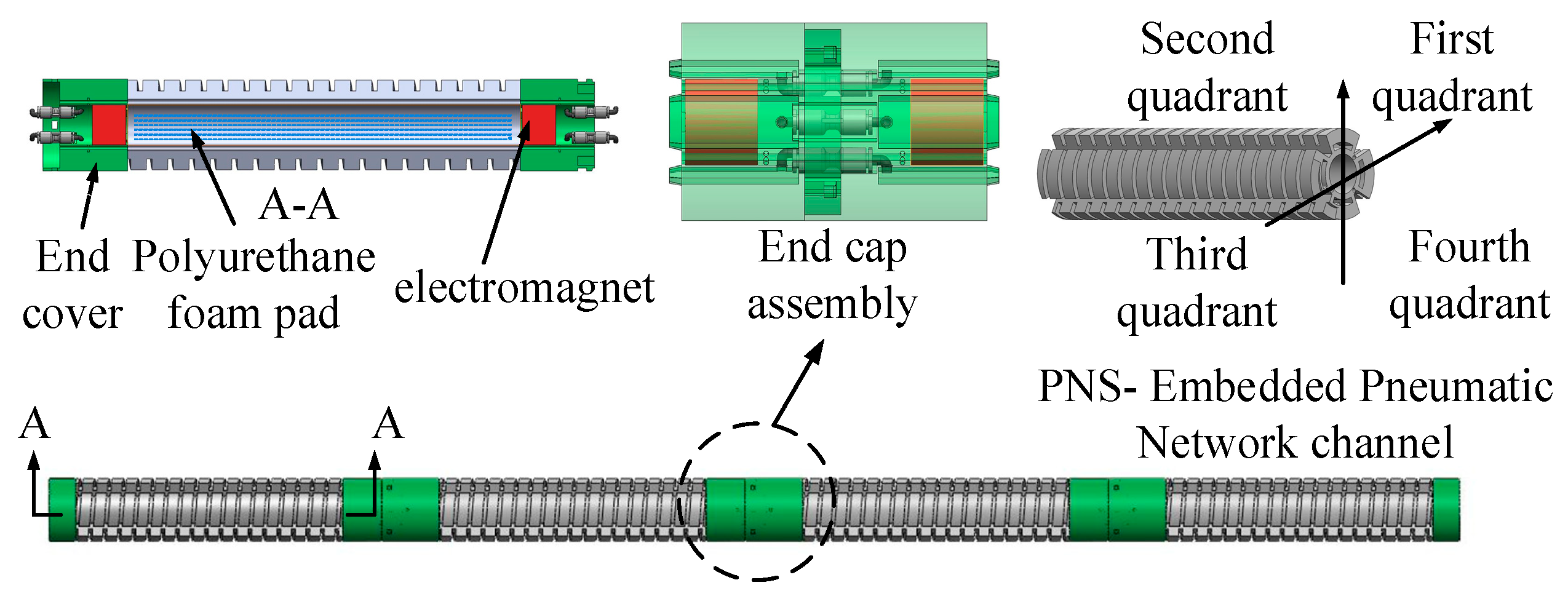
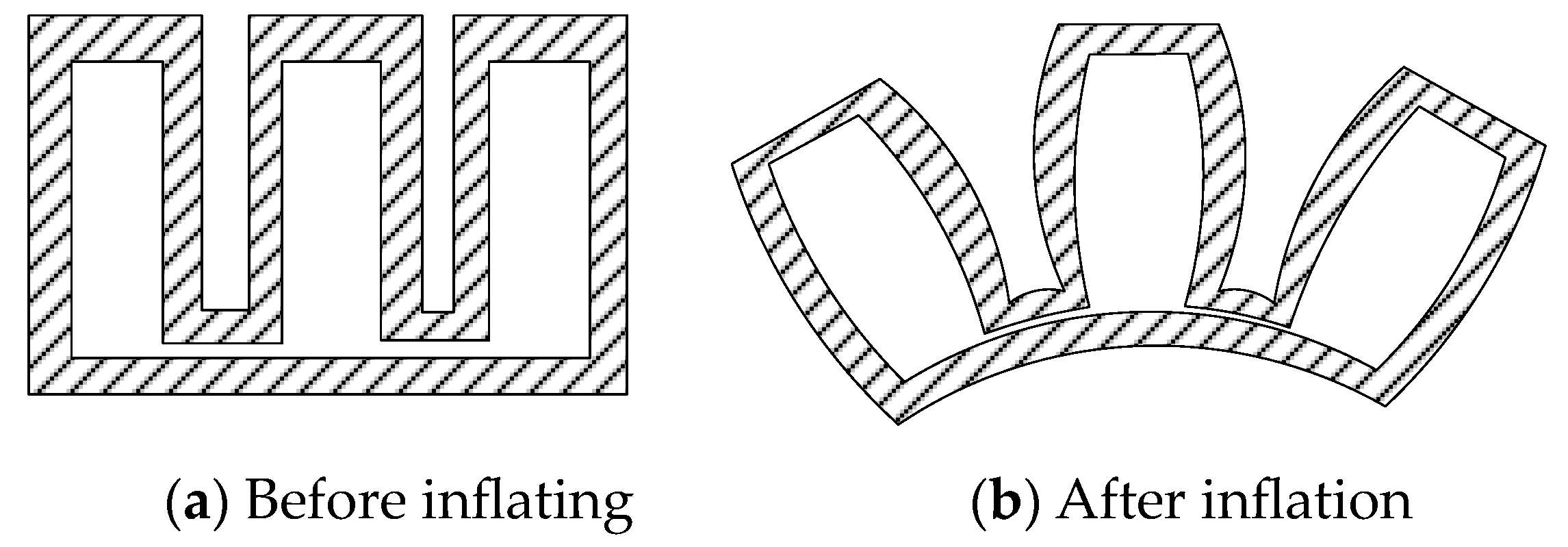
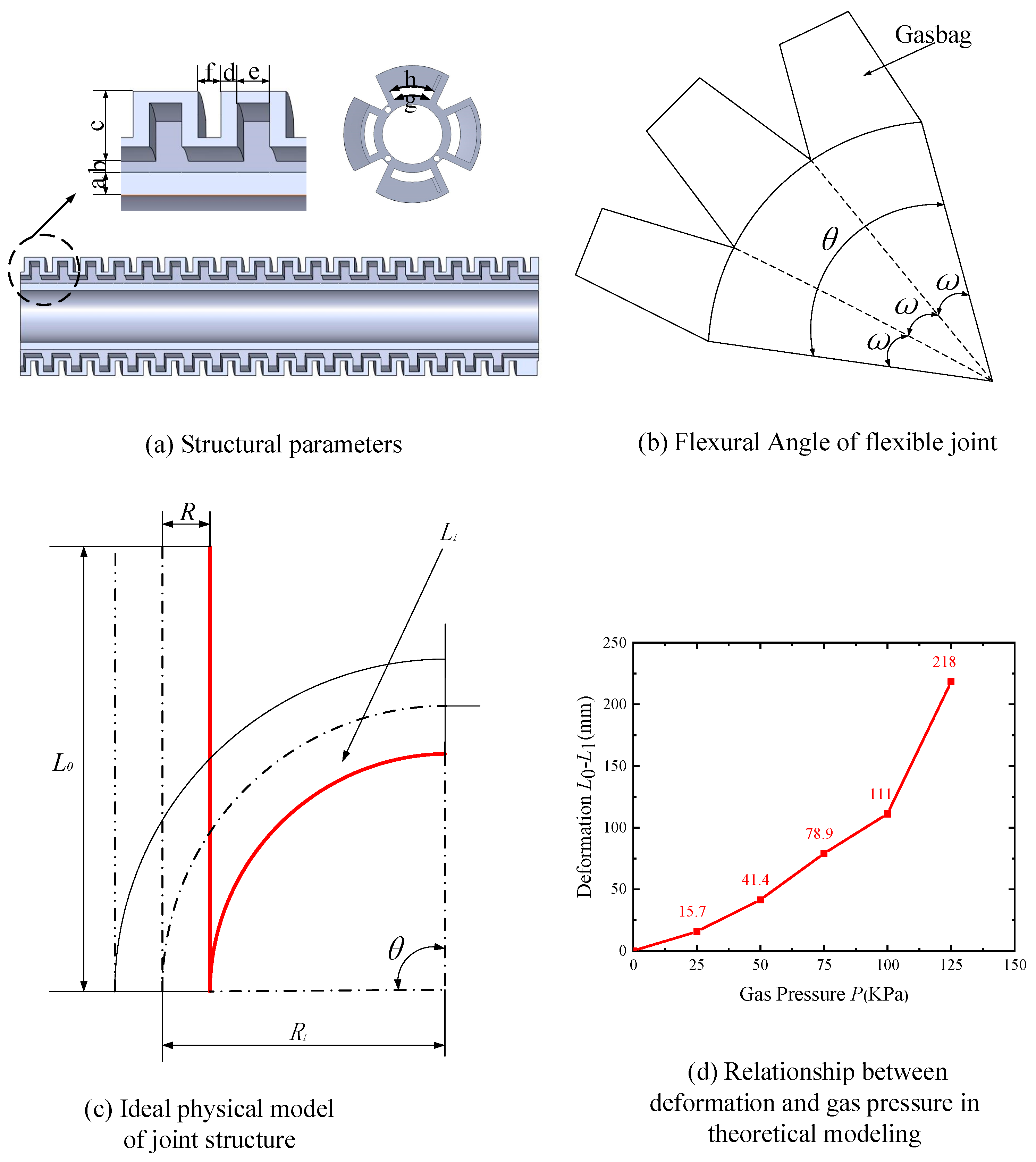
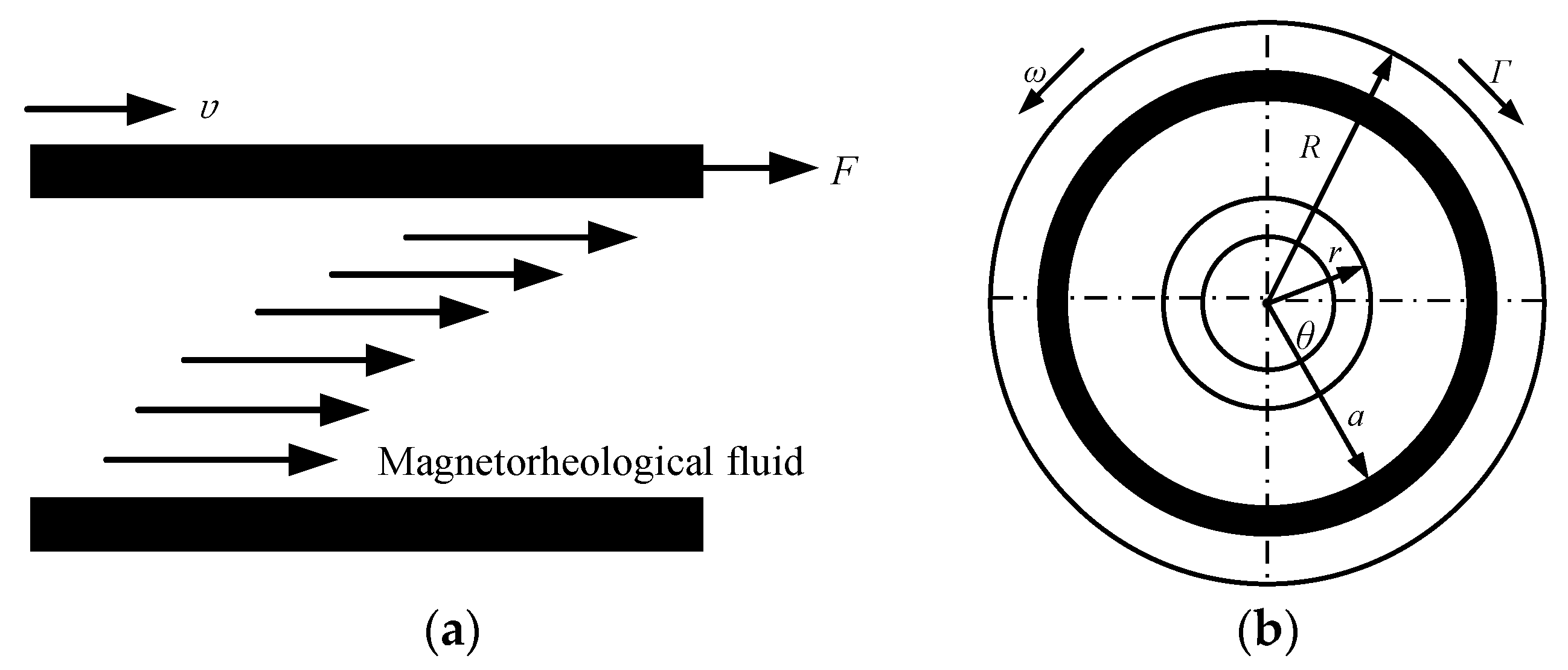

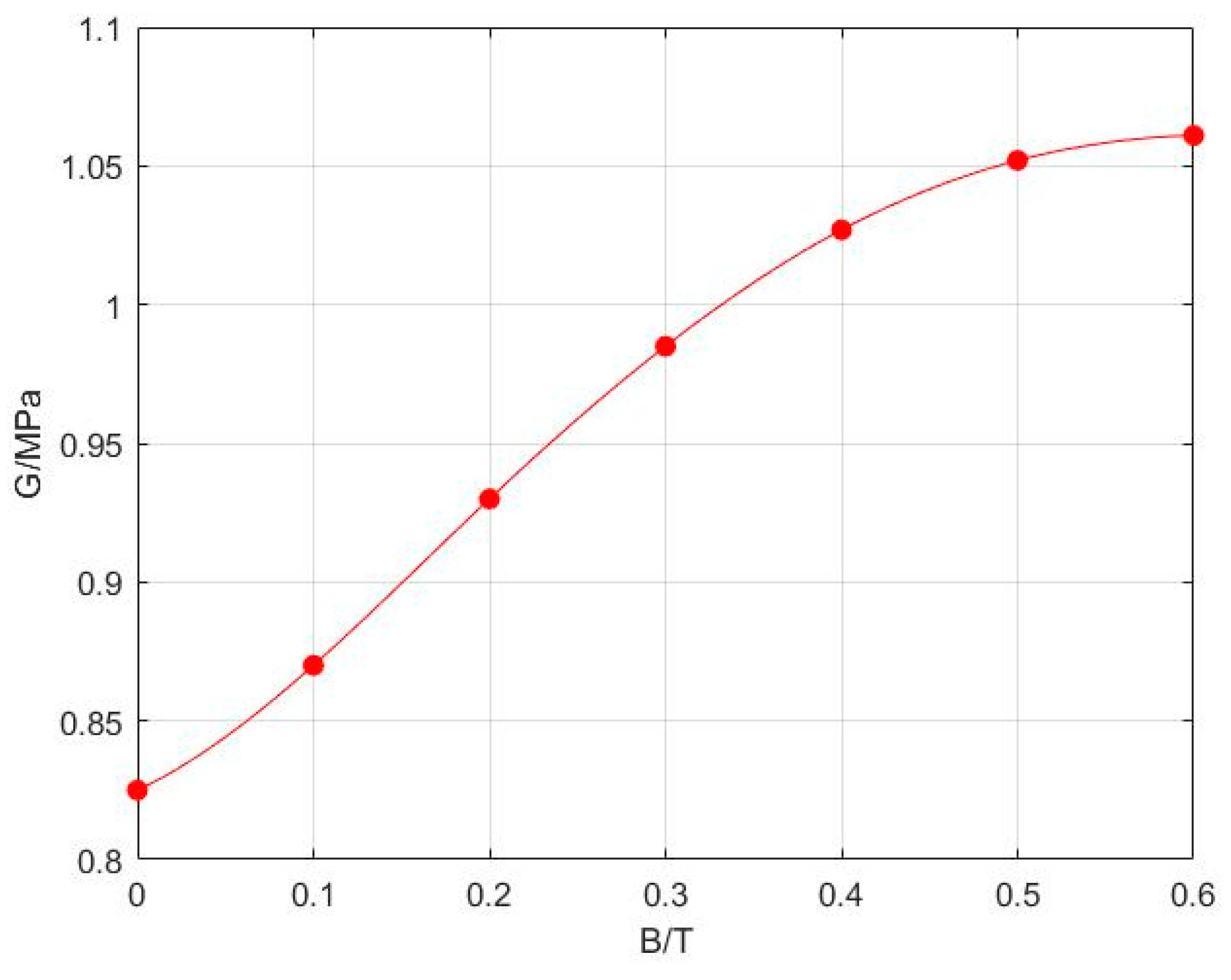



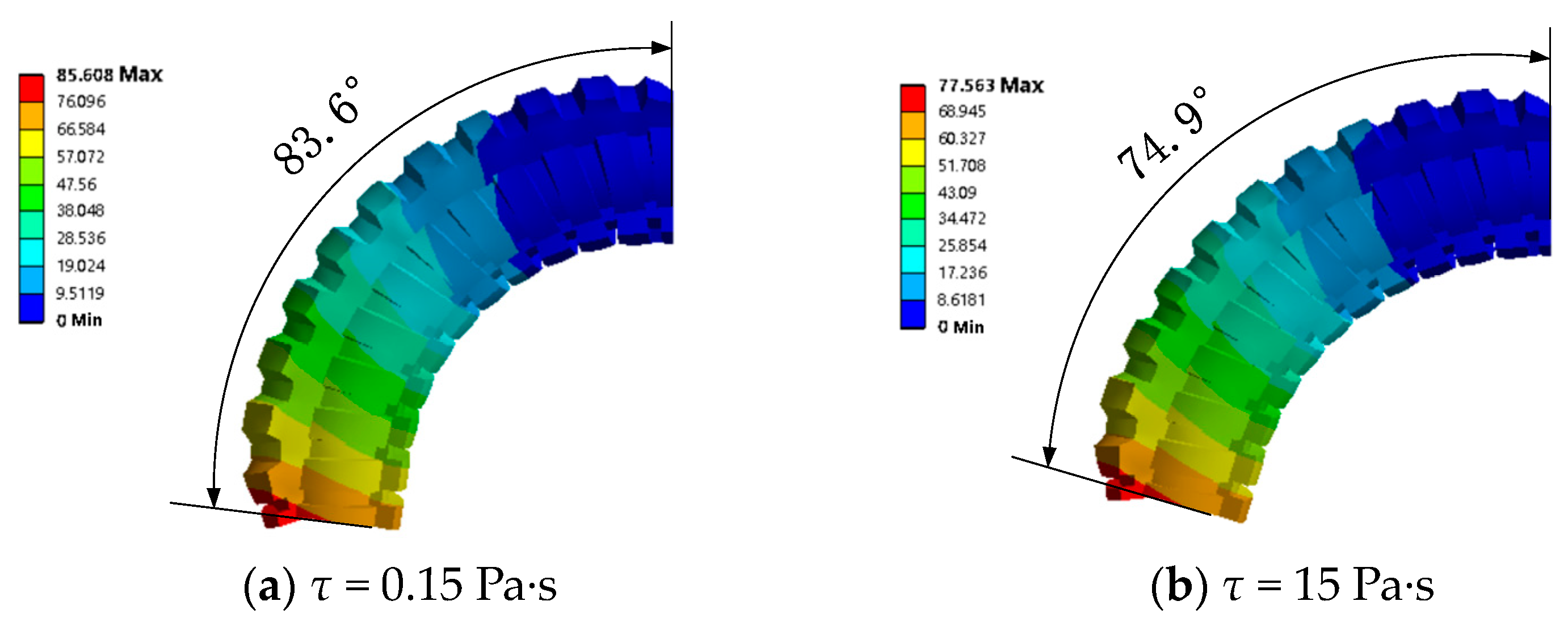
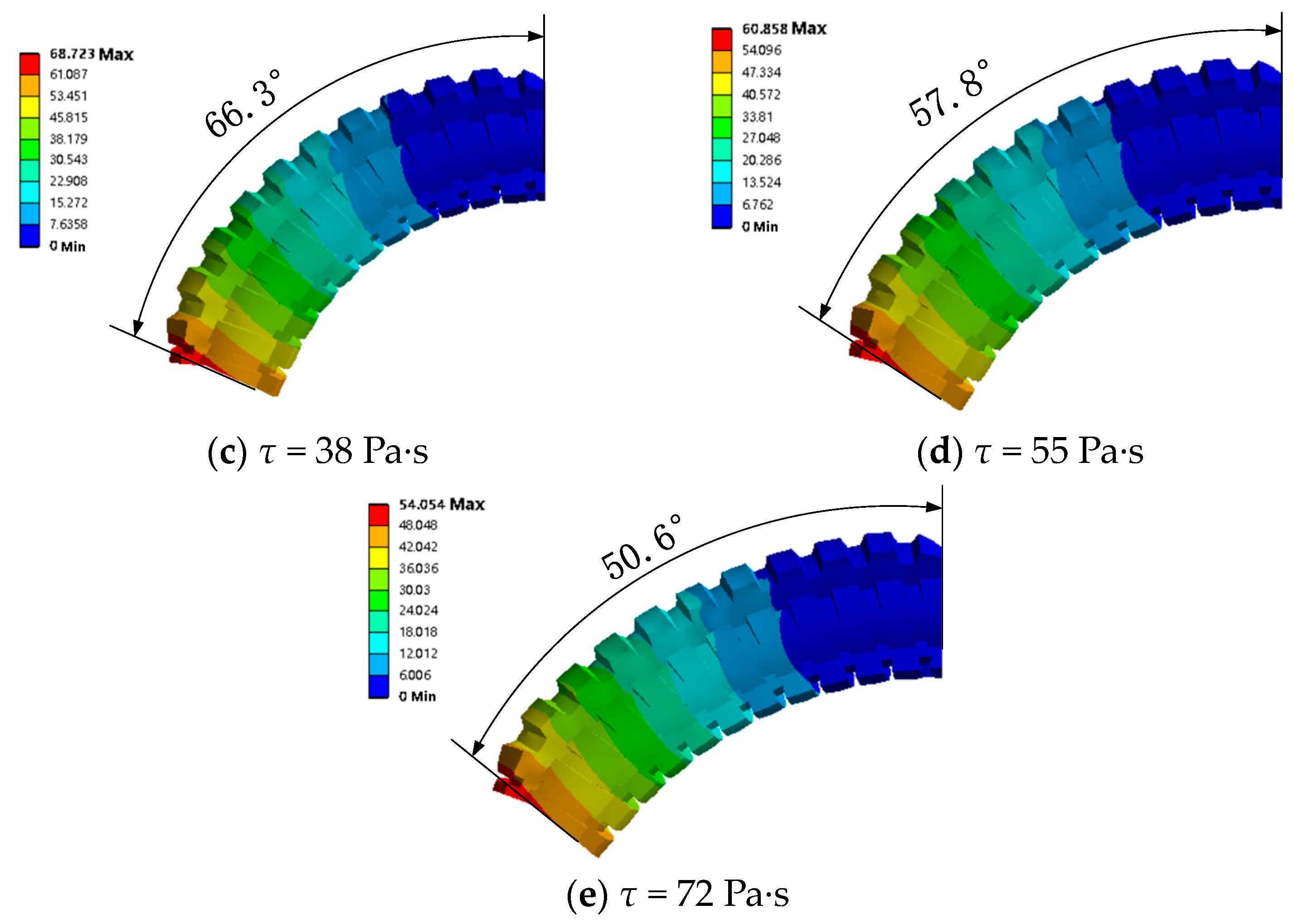
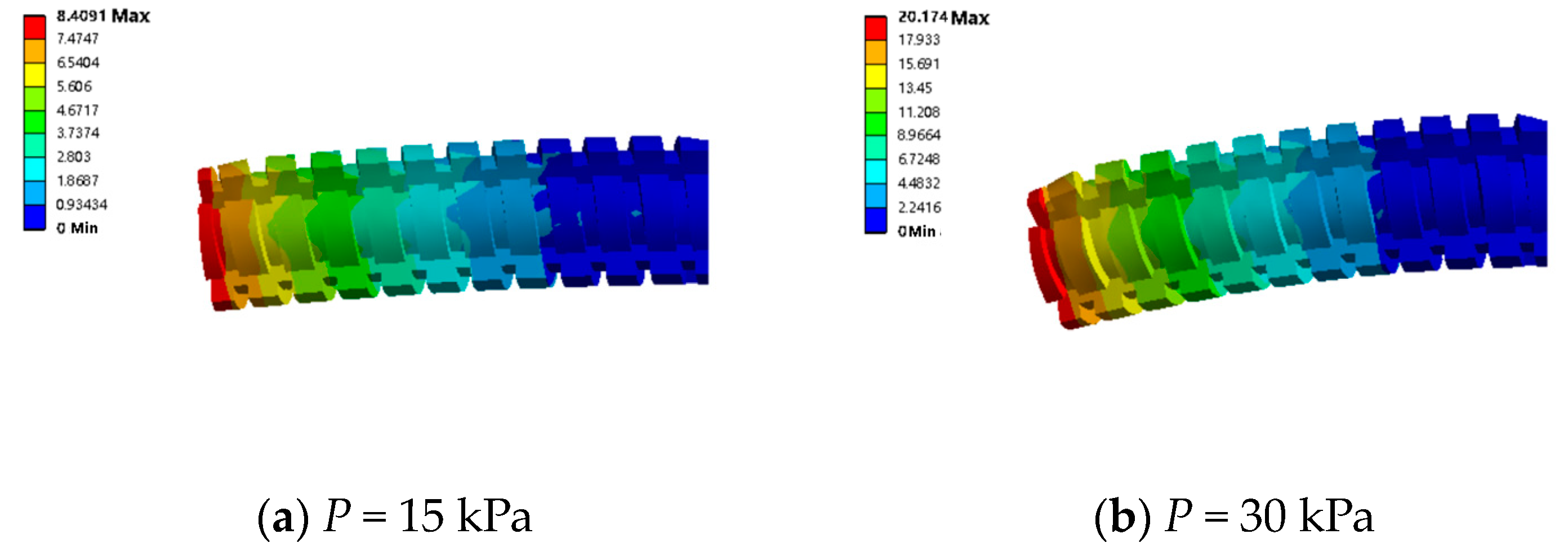
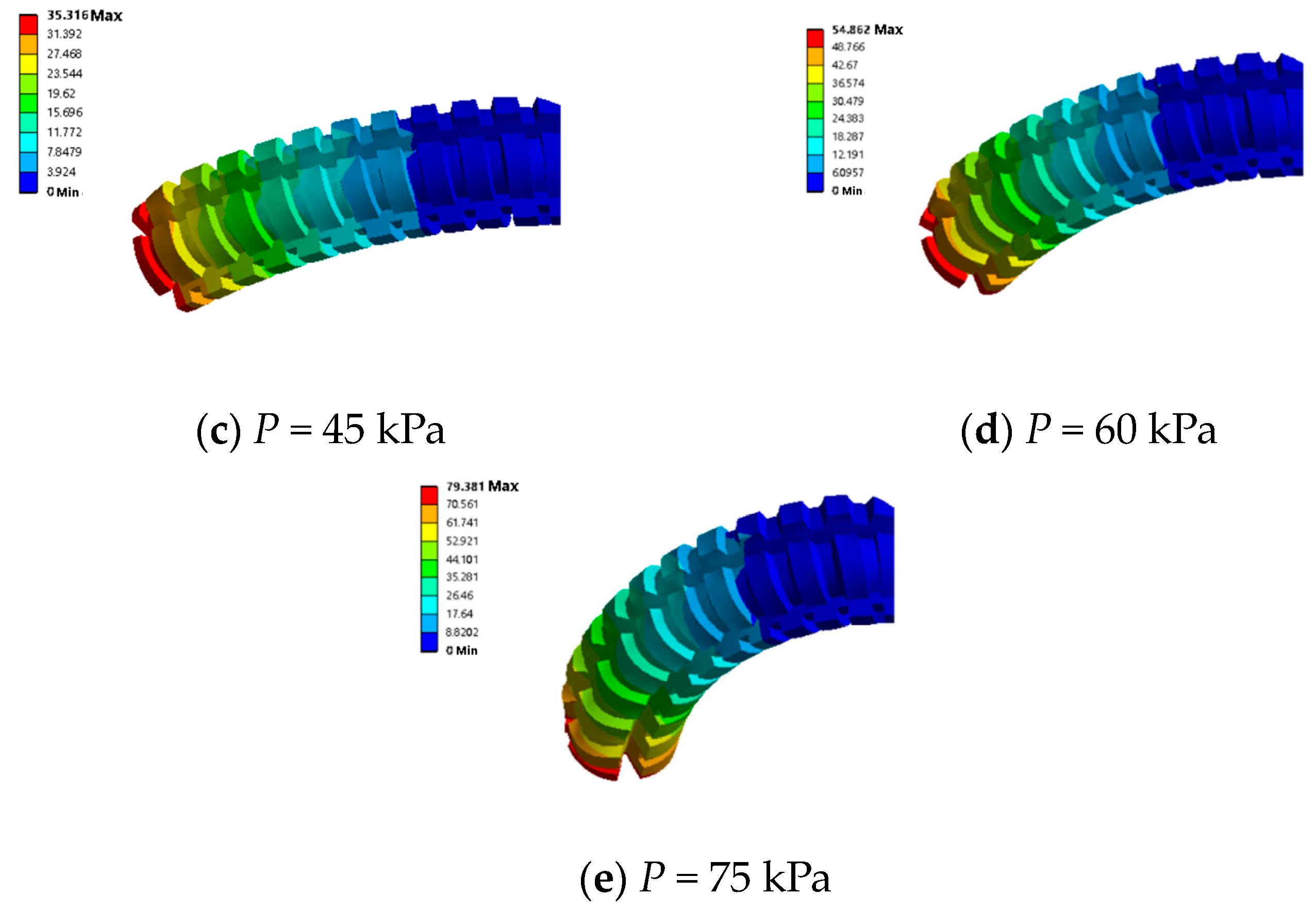
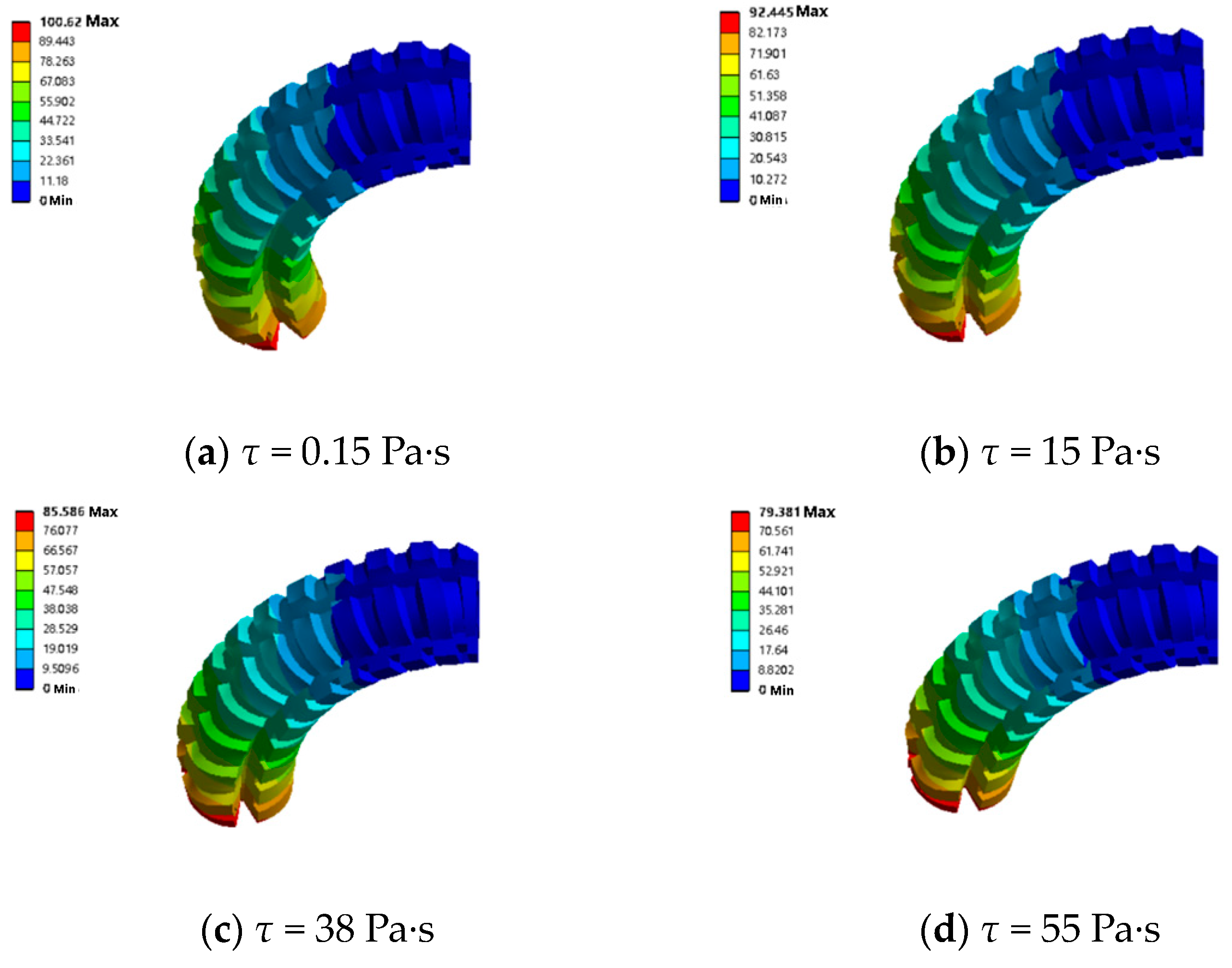
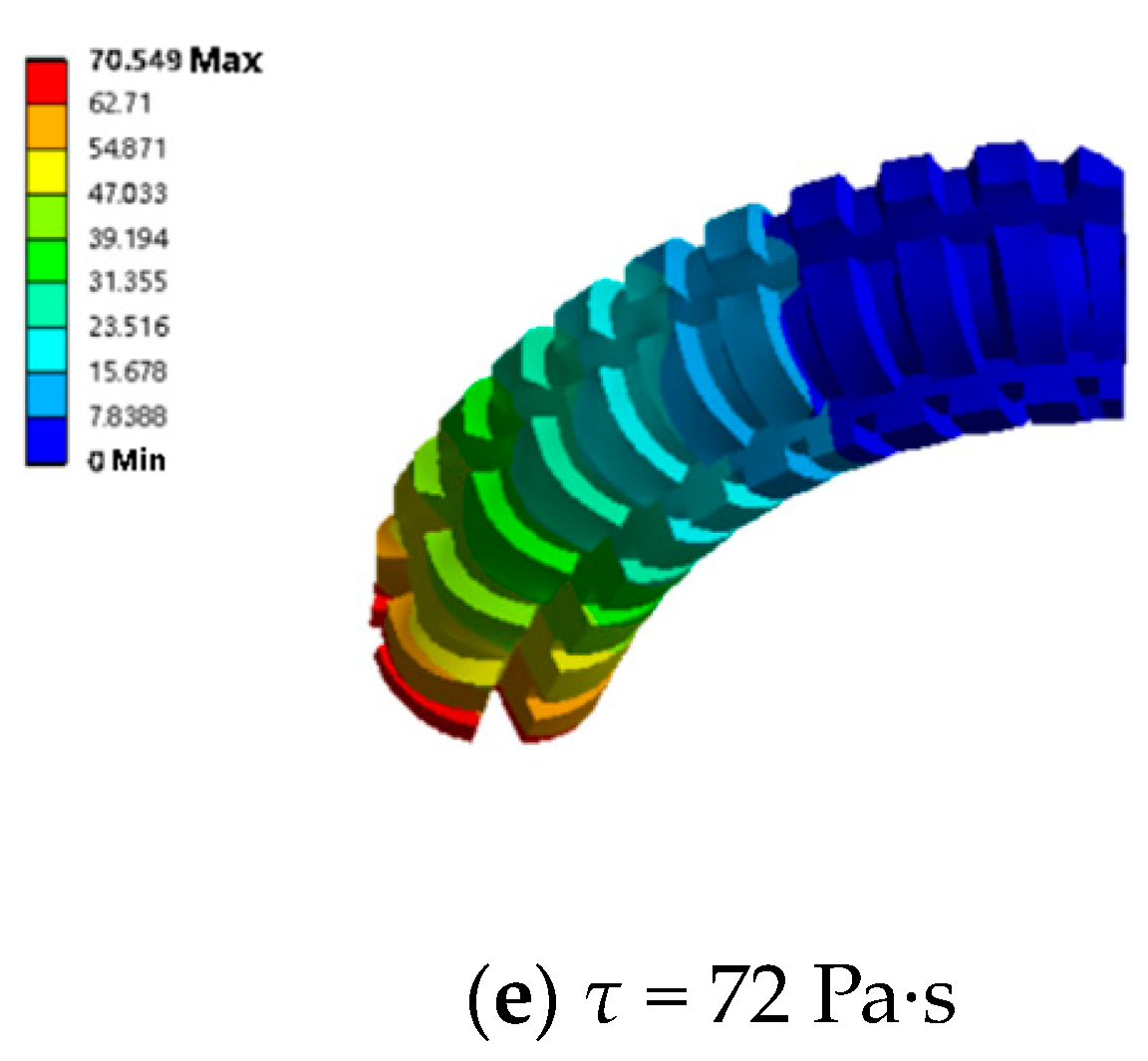
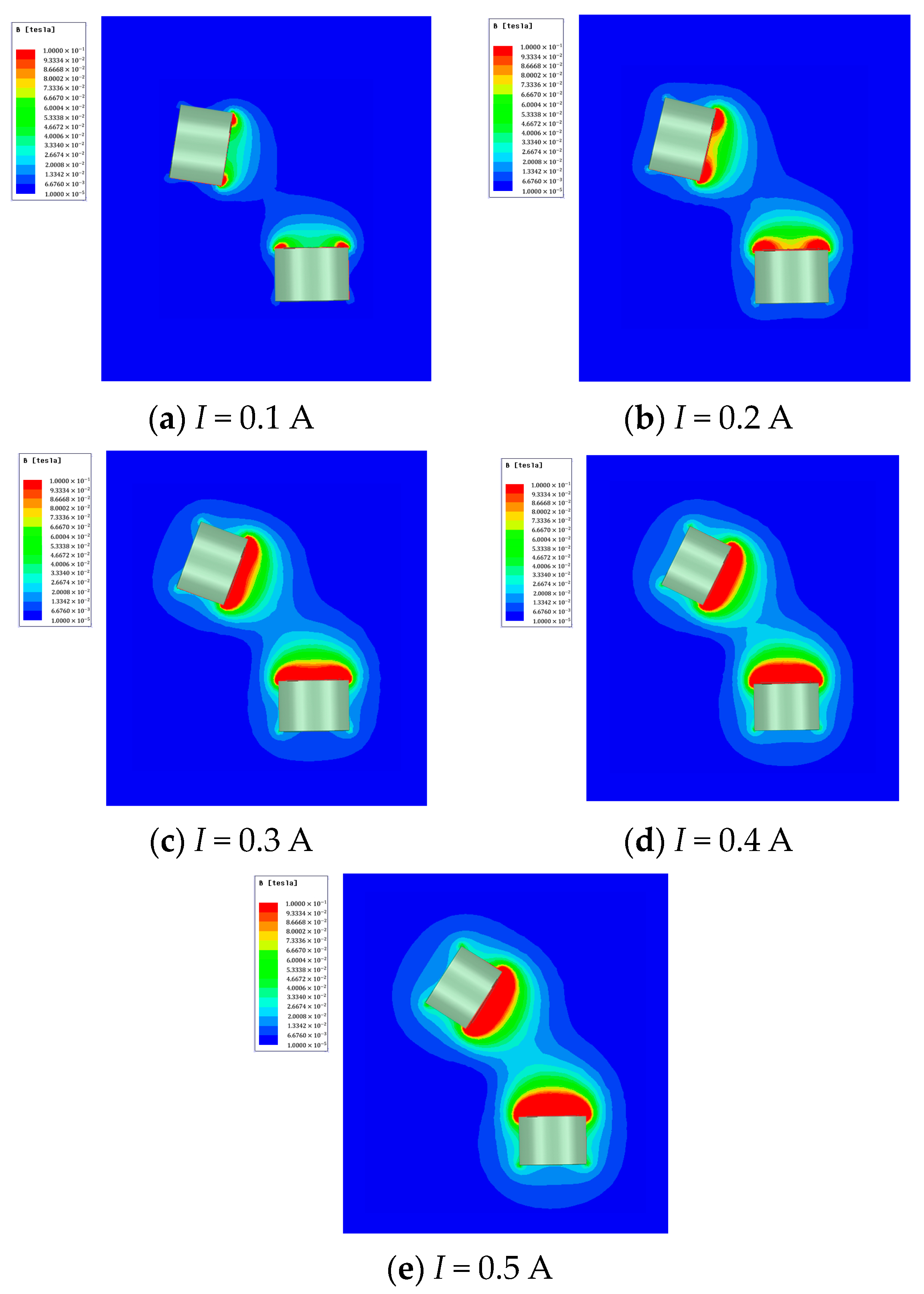
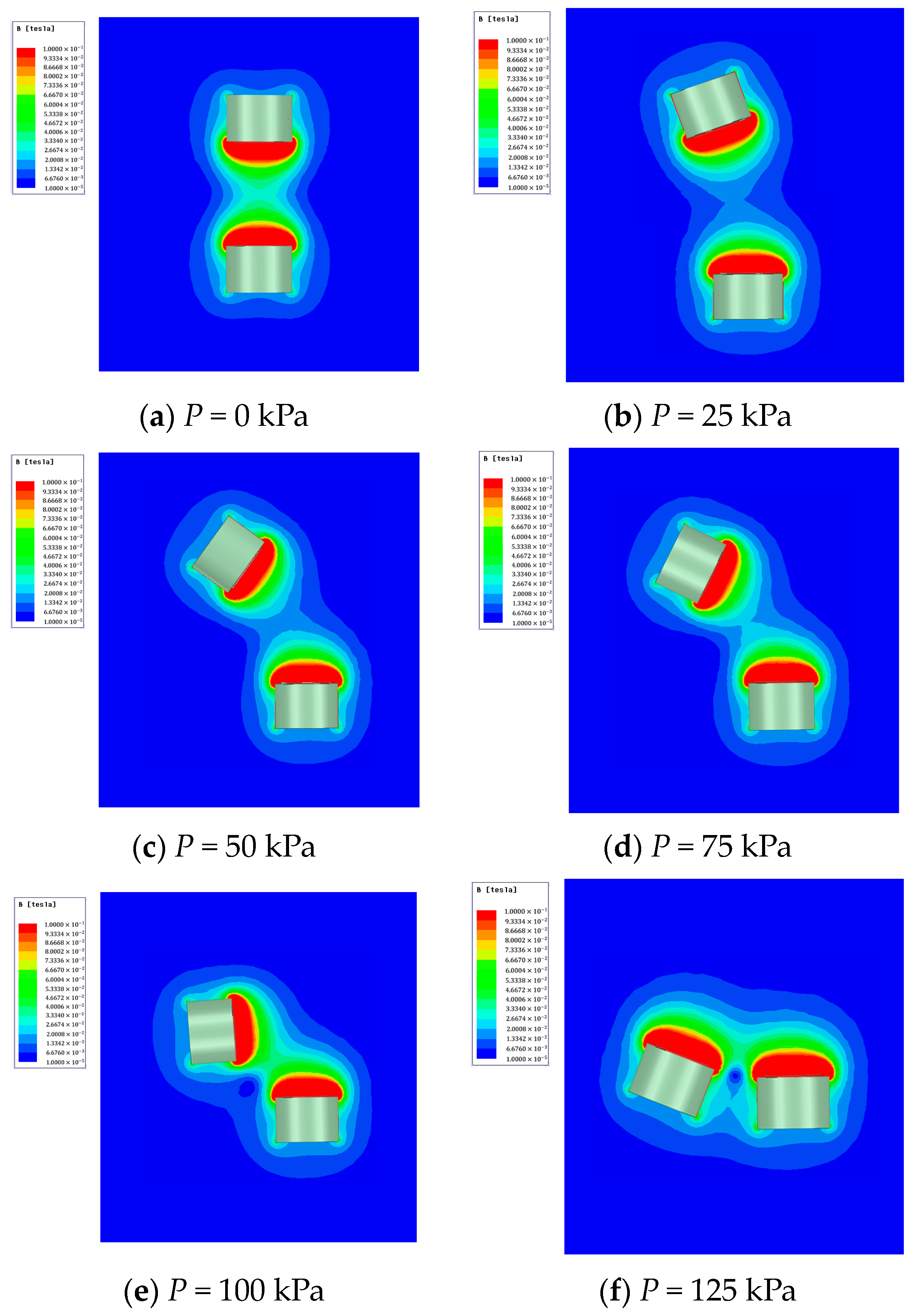
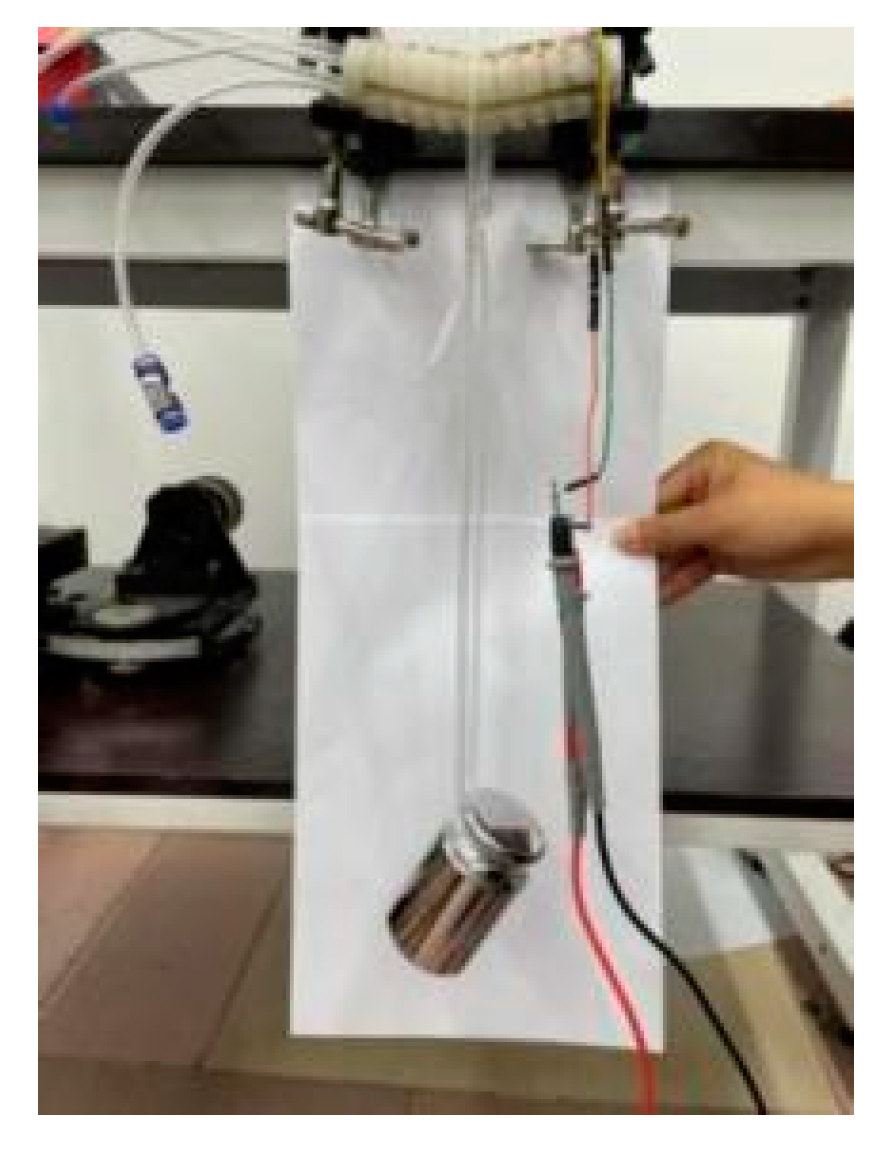
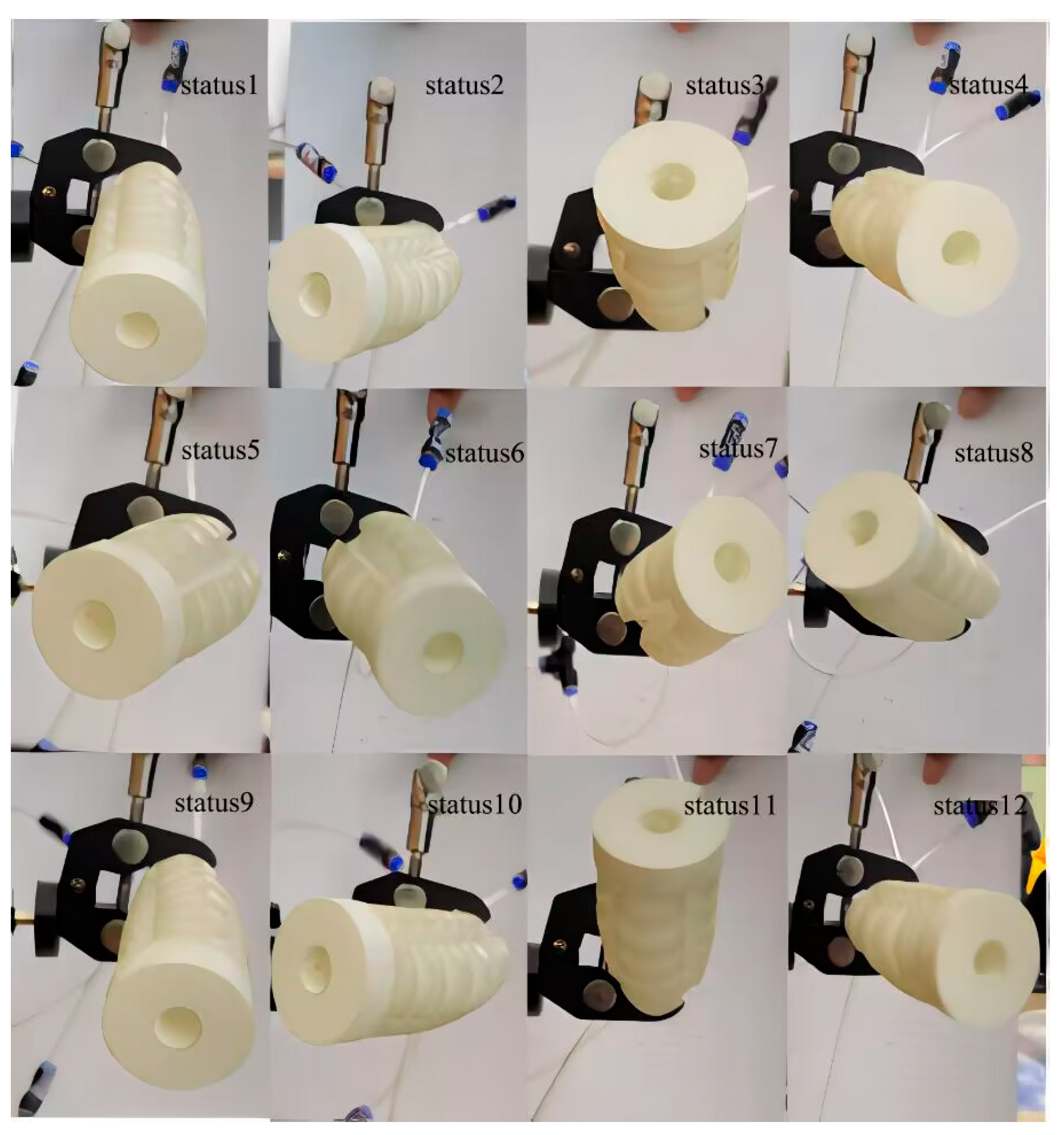
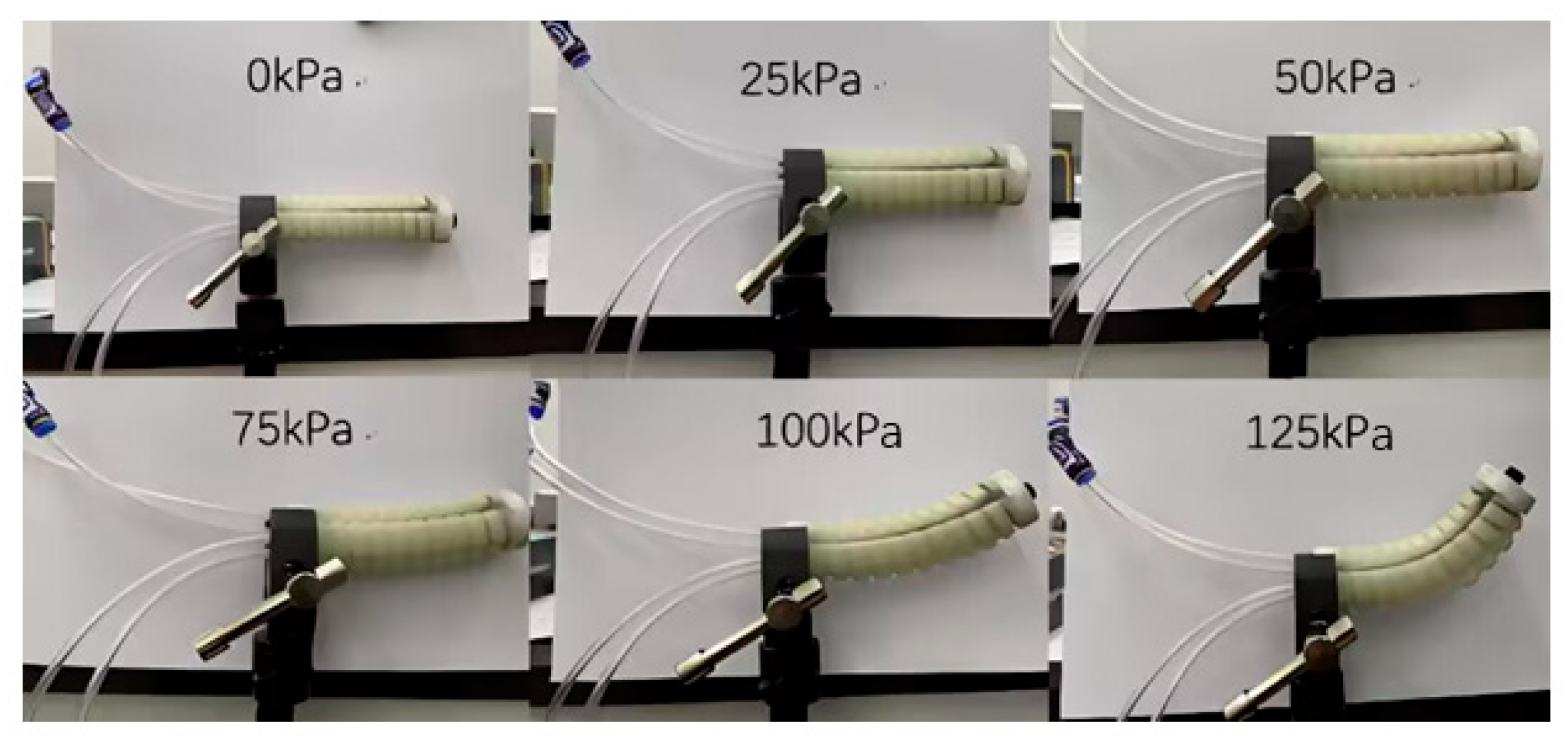
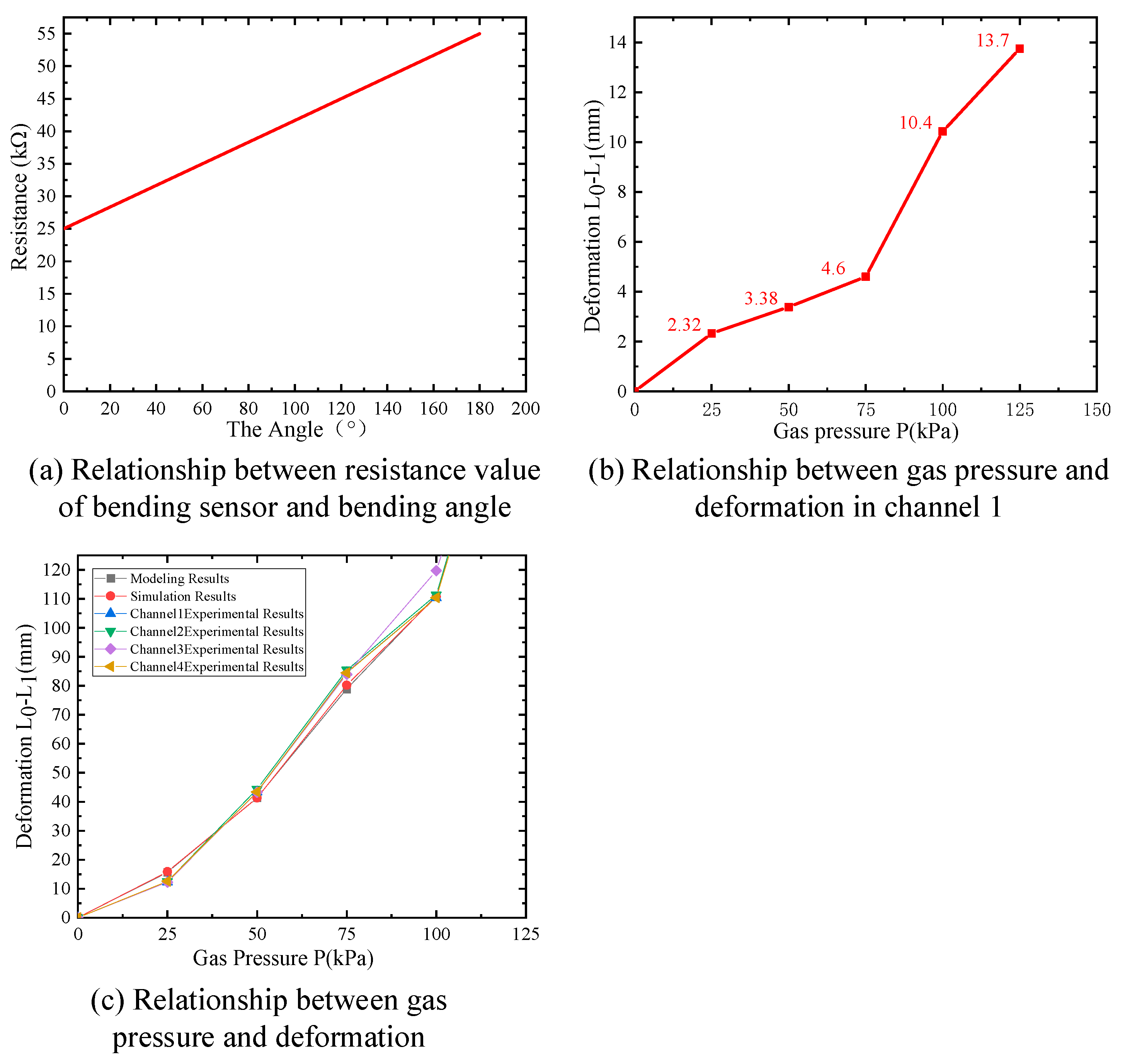

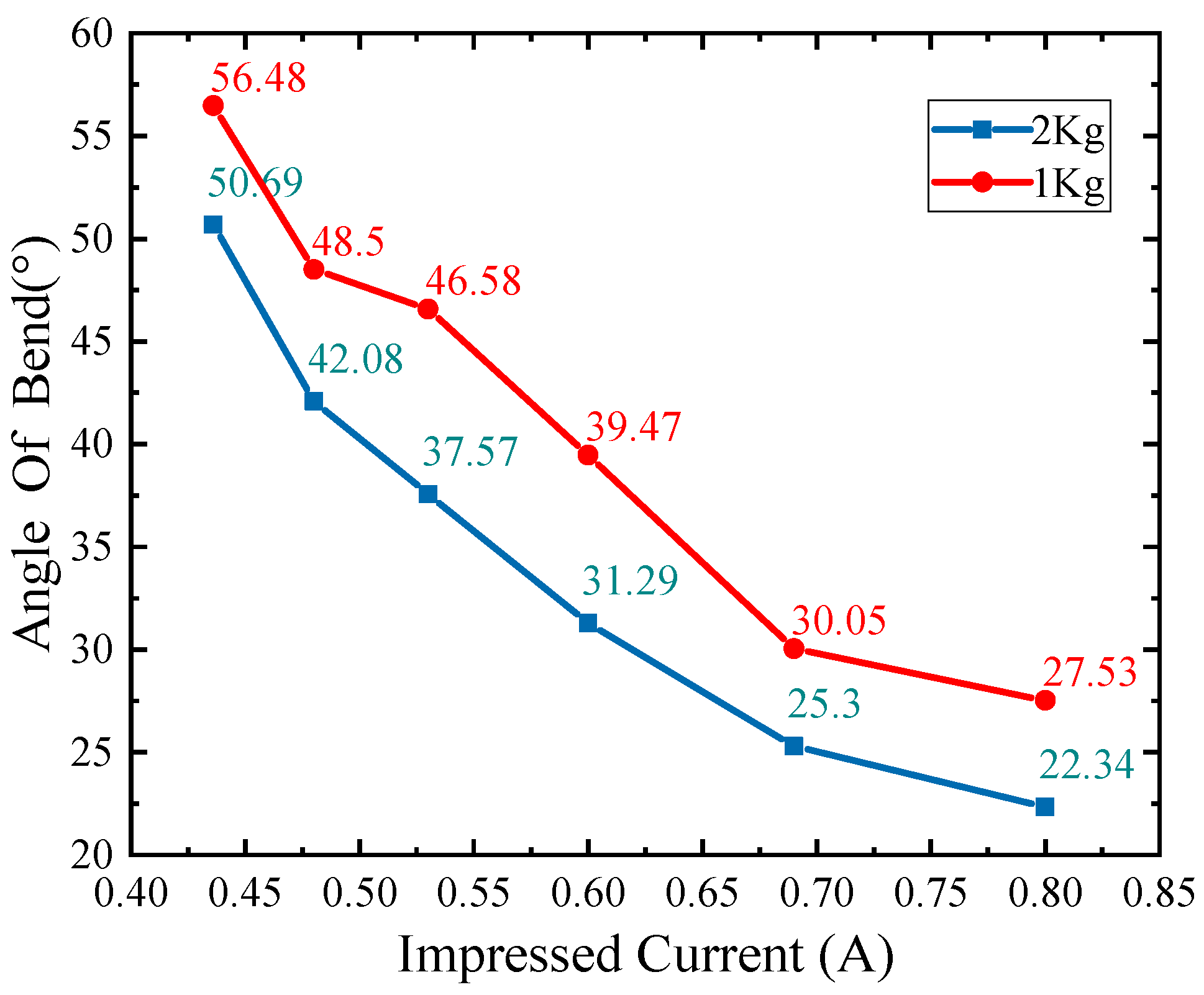
| Property | Argument |
|---|---|
| Hardness | 50 A |
| Tensile strength | 7.5 MPa |
| Elongation at break | 350% |
| Tear strength | 18 N/mm |
| Shore hardness | 65 |
| Flame retardant grade | UL94 V-0 |
| Operating temperature range | −60 °C to +200 °C |
| Dielectric strength | 20 kV/mm |
| Volume resistivity | 1 × 1014 Ω-cm |
| Parameter | Value |
|---|---|
| The thickness of a single air chamber constraint layer | |
| The thickness of the cavity wall in the length direction of a single cavity | |
| Cavity wall thickness in the height direction | |
| Cavity wall thickness in the width direction | |
| The length of the cavity in the direction of the height of a single air cavity | |
| Single air cavity length direction empty cavity length | |
| Width direction cavity length | |
| The spacing between air cavities | |
| Width of vent between air cavity and air cavity |
| P (kPa) | 0 | 25 | 50 | 75 | 100 | 125 |
| θ (°) | 0 | 27.8 | 51.4 | 120.3 | 165.4 | 335.3 |
| Diameter (mm) | High (mm) | Table Magnetic Intermediate Magnetic Field Strength (T) | Nominal Voltage (V) | Weight (g) |
|---|---|---|---|---|
| 35 | 30 | 0.1 | 24 | 200 |
| Working Condition | Viscosity (Pa·s) | Gas Pressure (kPa) | Gas Pressure (kPa) | Gas Pressure (kPa) | Gas Pressure (kPa) | Gas Pressure (kPa) |
|---|---|---|---|---|---|---|
| 1 | 0 | 25 | 50 | 75 | 100 | 125 |
| 2 | 15 | 25 | 50 | 75 | 100 | 125 |
| 3 | 38 | 25 | 50 | 75 | 100 | 125 |
| 4 | 55 | 25 | 50 | 75 | 100 | 125 |
| 5 | 72 | 25 | 50 | 75 | 100 | 125 |
| Working Condition | Viscosity (Pa·s) | Gas Pressure (kPa) | Gas Pressure (kPa) | Gas Pressure (kPa) | Gas Pressure (kPa) | Gas Pressure (kPa) |
|---|---|---|---|---|---|---|
| 1 | 0 | 15 | 30 | 45 | 60 | 75 |
| 2 | 15 | 15 | 30 | 45 | 60 | 75 |
| 3 | 38 | 15 | 30 | 45 | 60 | 75 |
| 4 | 55 | 15 | 30 | 45 | 60 | 75 |
| 5 | 72 | 15 | 30 | 45 | 60 | 75 |
| Channel Number | 1 | 2 | 3 | 4 | The Deformation L0-L1 (mm) | |
|---|---|---|---|---|---|---|
| State | ||||||
| 1 | + | 0 | 0 | 0 | 10 | |
| 2 | 0 | + | 0 | 0 | 10 | |
| 3 | 0 | 0 | + | 0 | 10 | |
| 4 | 0 | 0 | 0 | + | 10 | |
| 5 | + | + | 0 | 0 | 10 | |
| 6 | 0 | + | + | 0 | 10 | |
| 7 | 0 | 0 | + | + | 10 | |
| 8 | + | 0 | 0 | + | 10 | |
| 9 | + | 0 | - | 0 | 13.5 | |
| 10 | 0 | + | 0 | - | 13.5 | |
| 11 | - | 0 | + | 0 | 13.5 | |
| 12 | 0 | - | 0 | + | 13.5 | |
| Air pressure (kPa) | 0 | 25 | 50 | 75 | 100 | 125 |
| The sensor (KΩ) | 25 | 26.5 | 27.2 | 28.1 | 31.8 | 34.2 |
Disclaimer/Publisher’s Note: The statements, opinions and data contained in all publications are solely those of the individual author(s) and contributor(s) and not of MDPI and/or the editor(s). MDPI and/or the editor(s) disclaim responsibility for any injury to people or property resulting from any ideas, methods, instructions or products referred to in the content. |
© 2023 by the authors. Licensee MDPI, Basel, Switzerland. This article is an open access article distributed under the terms and conditions of the Creative Commons Attribution (CC BY) license (https://creativecommons.org/licenses/by/4.0/).
Share and Cite
Liu, S.; Bian, Y.; Ai, C.; Sun, H.; Deng, Y.; Chen, Z.; Chen, X.; Zhang, J. Analysis of Rigid-Flexible Coupling Characteristics of Pneumatic Modular Soft Joints with Variable Stiffness. Machines 2023, 11, 714. https://doi.org/10.3390/machines11070714
Liu S, Bian Y, Ai C, Sun H, Deng Y, Chen Z, Chen X, Zhang J. Analysis of Rigid-Flexible Coupling Characteristics of Pneumatic Modular Soft Joints with Variable Stiffness. Machines. 2023; 11(7):714. https://doi.org/10.3390/machines11070714
Chicago/Turabian StyleLiu, Siyuan, Yuhang Bian, Chao Ai, Hongmei Sun, Yijie Deng, Zilong Chen, Xiaorui Chen, and Jingtao Zhang. 2023. "Analysis of Rigid-Flexible Coupling Characteristics of Pneumatic Modular Soft Joints with Variable Stiffness" Machines 11, no. 7: 714. https://doi.org/10.3390/machines11070714
APA StyleLiu, S., Bian, Y., Ai, C., Sun, H., Deng, Y., Chen, Z., Chen, X., & Zhang, J. (2023). Analysis of Rigid-Flexible Coupling Characteristics of Pneumatic Modular Soft Joints with Variable Stiffness. Machines, 11(7), 714. https://doi.org/10.3390/machines11070714







